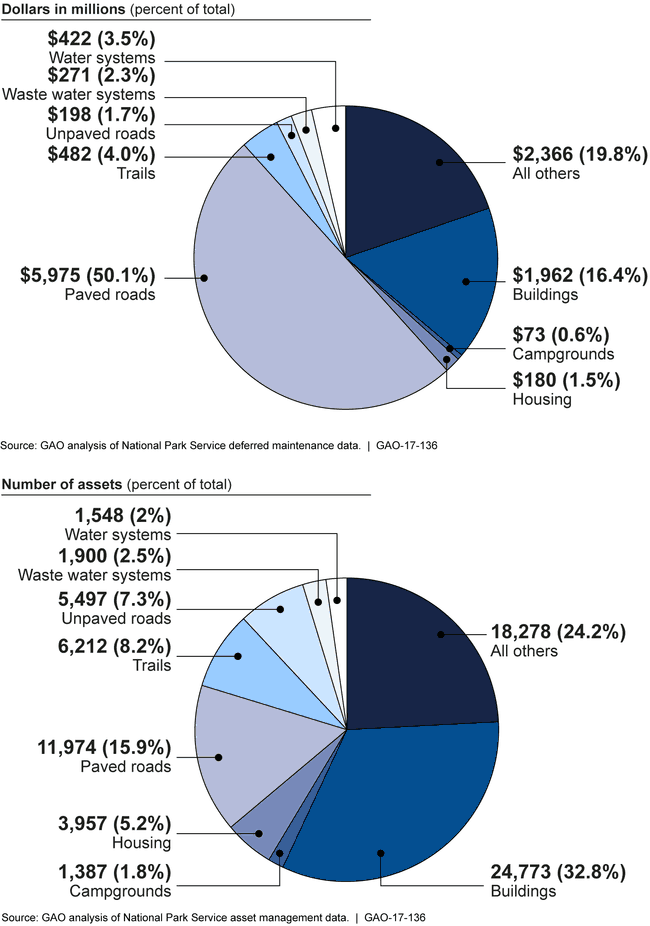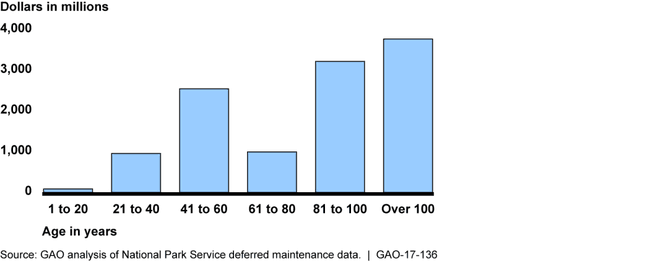National Park Service: Process Exists for Prioritizing Asset Maintenance Decisions, but Evaluation Could Improve Efforts
Fast Facts
At the end of fiscal year 2015, the National Park Service reported $11.9 billion in deferred maintenance—that is, the estimated costs of asset maintenance or repairs that the agency has postponed for more than a year and has not yet resolved.
To address its maintenance needs, the agency has determined that its highest priority assets—assets that are critical to the operation of parks—should be considered first for funding to keep them in good condition.
The agency has not yet evaluated this approach and does not have plans underway to do so. We recommend that the Park Service evaluate whether this approach is working or if changes are needed.
Dollar Amount of National Park Service’s $11.9 Billion in Deferred Maintenance and Number of Assets by Asset Category, Fiscal Year 2015

Highlights
What GAO Found
In fiscal years 2006 through 2015, the Department of the Interior's National Park Service (Park Service) allocated, on average, $1.16 billion annually to maintain assets. In fiscal year 2015, allocations to maintenance accounted for about one-third (or $1.08 billion) of the agency's total funding of $3.3 billion. The largest portion of maintenance funds in fiscal year 2015 was allocated to facility operations, which includes maintenance that is routine in nature, such as maintenance of trails.
The Park Service's deferred maintenance—maintenance of its assets that was not performed when it should have been and is delayed for a future period—averaged $11.3 billion from fiscal years 2009 through 2015. Bridges, tunnels, and paved roadways consistently made up the largest share of the agency's deferred maintenance, accounting for half of all deferred maintenance in fiscal year 2015. Older park units have the most deferred maintenance, with $10.5 billion in fiscal year 2015 in park units established more than 40 years ago.
National Park Service's Deferred Maintenance by Age of Park Unit in Fiscal Year 2015

The Park Service uses several tools to determine an asset's importance and condition and assign maintenance priority. Park unit staff assess the condition of the asset and identify maintenance projects. Once identified, park unit staff use the agency's Capital Investment Strategy to evaluate and rank projects. Projects score higher if they target critical assets with deferred maintenance. Fiscal year 2015 was the first budget year in which projects ranked using the strategy were funded, and regional and park unit officials said that it is too soon to determine if the strategy is meeting its objectives, such as maintaining the condition of its most important assets. However, the Park Service does not have a plan or timeframe for evaluating whether the strategy has been successful. A senior official said that the agency has not determined what is needed to begin such an evaluation and that it would be beneficial to verify that the Capital Investment Strategy is achieving intended outcomes. According to the National Academies Federal Facilities Council, it is important that agencies track the outcome of investments to improve decision making and asset management. Evaluating the strategy may help the Park Service determine if the strategy is achieving intended outcomes or if changes need to be made.
Why GAO Did This Study
The Park Service manages more than 75,000 assets, including buildings, roads, and water systems, at 413 park units across all 50 states. In 2015, the agency estimated that its deferred maintenance on these assets was $11.9 billion.
GAO was asked to review how the Park Service manages its maintenance needs. This report examines, among other things, (1) agency allocations to maintain assets in fiscal years 2006 through 2015, (2) the amount and composition of the agency's deferred maintenance in fiscal years 2009 through 2015, and (3) how the agency makes maintenance decisions. To conduct this work, GAO analyzed Park Service allocation data for fiscal years 2006 through 2015 and deferred maintenance data in fiscal years 2009 (first year data for all assets was available) through 2015 (most current data available); reviewed planning and guidance documents and compared the process for making asset management decisions to guidance developed by the National Academies, among others; and interviewed Park Service officials at headquarters, all seven regions, and 21 park units selected to include those with large and small amounts of deferred maintenance, among other things. This sample is not generalizable to all park units.
Recommendations
GAO recommends that the Park Service evaluate the Capital Investment Strategy and results to assess whether it has achieved its intended outcomes. The Department of the Interior agreed with GAO's recommendation.
Recommendations for Executive Action
| Agency Affected | Recommendation | Status |
|---|---|---|
| Department of the Interior | To ensure that the elements of the agency's process for making asset maintenance decisions are achieving desired outcomes, the Secretary of the Interior should direct the Director of the Park Service to evaluate the Capital Investment Strategy and its results to determine if it is achieving its intended outcomes or if changes need to be made. |
The National Park Service (NPS) has evaluated the Capital Investment Strategy and continues to make modifications to it to ensure it is achieving its intended outcomes. In 2019, the agency established a Capital Investment Strategy working group, and it was tasked with reviewing and overseeing the algorithm that forms the basis for the strategy. Based on these results, the agency determined that the Capital Investment Strategy is partially achieving its intended outcomes. Specifically, since the implementation of the strategy in FY2015, NPS has made progress towards financial sustainability by, for example, increasing investments in mission critical assets. In addition, NPS has focused on disposing of non-essential facilities to avert their associated deferred maintenance and avoid the future growth of deferred maintenance of these facilities. NPS has also improved the visitor experience through increased funding in public use facilities, per the intent of the strategy. For example, investment in assets that primarily support visitor use have increased 11 percent from 2013 to 2018, according to officials. NPS has also increased investments in health and life safety related work to ensure visitor and employee safety, also consistent with the strategy, according to agency officials. However, the agency also found that it continued to invest in protecting historic and cultural resources at a consistent rate, rather than a declining rate, thereby only partially meeting the intent of the Capital Investment Strategy. According to agency officials, NPS is proactively taking steps to continuously improve its asset management program and investment strategies, including assessing prioritization methods at the park, region, and national levels. For example, it is standing up a new Investment Review Board that will provide a Park Service-wide perspective for and oversight of construction programs. The board will also be responsible for setting direction and priorities for facility investment. According to agency officials, NPS also is developing a new and simplified method for prioritizing assets for funding. Finally, NPS will be implementing periodic evaluations of the facility investment strategy and the Capital Investment Strategy to ensure that investments are aligned with departmental goals and priorities.
|
